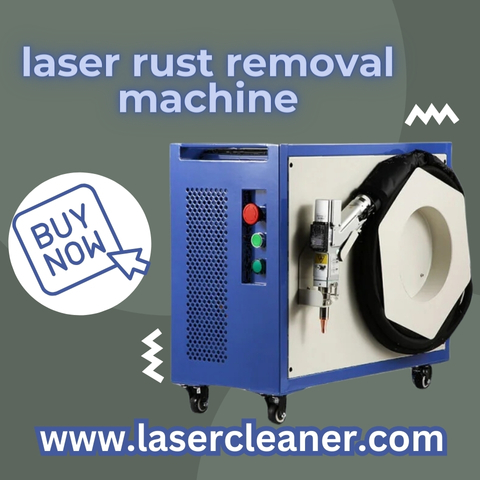A laser rust removal machine has emerged as a powerful tool in modern industries where rust, oxidation, and surface contamination create consistent challenges. Traditional cleaning methods like sandblasting, chemical solvents, and abrasive grinding often lead to material damage, high maintenance costs, and time-consuming processes. By contrast, laser rust removal machines use a highly concentrated laser beam to strip away rust without harming the underlying material.
This technology has gained recognition across automotive, aerospace, shipbuilding, construction, and manufacturing sectors. The precision, speed, and adaptability of these machines make them one of the most effective solutions for dealing with corroded surfaces, preparing parts for welding, and restoring metal components.
In this detailed guide, we will examine the working principle, applications, operational processes, and industry-specific benefits of laser rust removal machines.
Working Principle of a Laser Rust Removal Machine
The core mechanism of a laser rust removal machine is based on laser ablation. A pulsed or continuous laser beam is directed onto the rusted metal surface. The intense energy heats and vaporizes the rust layer, breaking its bond with the base material. This process removes contaminants with extreme accuracy, leaving behind a clean surface.
The laser can be fine-tuned for various cleaning depths and speeds. For light rust, lower intensity is sufficient, while deeper corrosion requires stronger pulses. Because the laser targets only the surface contaminants, the structural integrity of the metal remains intact.
Industrial Applications of Laser Rust Removal Machines
1. Automotive Manufacturing and Restoration
In the automotive sector, rust on car frames, panels, and parts can reduce performance and safety. A laser rust removal machine enables manufacturers and restoration specialists to clean body panels, remove old paint layers, and prepare surfaces for welding or coating without damaging the base metal. This method has become highly valuable for vintage car restorers who need delicate surface treatment.
2. Aerospace Engineering
Aircraft components are exposed to humidity, extreme temperatures, and chemical environments, leading to rust and oxidation. Using laser rust removal machines ensures high-precision cleaning of critical parts such as turbine blades, landing gears, and fuselage sections. This contributes to safer performance and compliance with strict aviation standards.
3. Shipbuilding and Marine Industry
Ships, docks, and marine equipment constantly face corrosion from seawater. Traditional cleaning methods are labor-intensive and hazardous. A laser rust removal machine simplifies the process by cleaning large steel structures, ship hulls, and pipelines efficiently, reducing downtime and improving maintenance schedules.
4. Construction and Heavy Equipment
Excavators, cranes, and construction materials are often exposed to outdoor conditions that accelerate rust. A laser rust removal machine allows operators to restore tools, machinery, and structural elements quickly, ensuring durability and performance in demanding environments.
5. Manufacturing and Production Lines
Factories using molds, stamping dies, and metal equipment rely on clean surfaces for efficient operation. Rust buildup slows down production and affects product quality. With laser rust removal machines, manufacturers achieve consistent cleaning, extend equipment lifespan, and reduce interruptions in production cycles.
Operational Process of Using a Laser Rust Removal Machine
- Surface Assessment – Operators first examine the rusted surface to determine the thickness of corrosion.
- Machine Setup – The machine is adjusted for power, wavelength, and beam size depending on the material.
- Laser Application – The laser beam is directed at the corroded surface, vaporizing the rust layer gradually.
- Monitoring – Operators monitor the process in real time to ensure precision cleaning without overexposure.
- Post-Cleaning – After the rust is removed, the surface may be coated, painted, or welded depending on the requirement.
This process is significantly faster and safer compared to chemical cleaning, as it does not involve harmful substances or abrasive contact.
Why Industries Choose Laser Rust Removal Machines
The adoption of laser rust removal machines has been driven by the need for precision, efficiency, and sustainability. Unlike traditional methods, these machines are versatile across different types of metals such as steel, aluminum, copper, and alloys. They minimize waste, reduce the use of consumables, and eliminate the need for hazardous chemicals.
Industries appreciate the adaptability of these machines, as they can be used for both large-scale operations and small, detailed work. Whether it is preparing parts for welding, restoring delicate machinery, or maintaining massive industrial equipment, the laser rust removal machine delivers results with minimal preparation time.
Safety and Maintenance of Laser Rust Removal Machines
Although laser rust removal machines are highly efficient, proper safety measures must always be followed. Operators should wear protective glasses, gloves, and use controlled work environments to avoid exposure to laser radiation. Ventilation systems are also recommended to safely disperse any particles or fumes generated during the process.
In terms of maintenance, these machines require regular inspection of optical components, cooling systems, and laser sources to ensure consistent performance. Compared to abrasive and chemical methods, the maintenance of a laser rust removal machine is minimal, adding to its long-term reliability.
Future of Laser Rust Removal Technology
With industries moving toward automation and sustainable practices, the laser rust removal machine is becoming an essential part of modern production systems. Integration with robotics, AI-driven controls, and portable handheld units will further expand their use in diverse fields. The push for environmentally friendly cleaning technologies ensures that laser systems will continue to replace older, less efficient methods.
Final Thoughts
The laser rust removal machine is transforming how industries approach rust, corrosion, and surface cleaning. Its precision, adaptability, and efficiency make it a valuable tool across automotive, aerospace, marine, construction, and manufacturing sectors. By eliminating the need for abrasive methods and harmful chemicals, it offers a modern solution that preserves material quality while saving time and costs. As technology advances, laser rust removal machines will continue to play a key role in industrial maintenance and production worldwide.
 WhatsApp Us Now
WhatsApp Us Now









